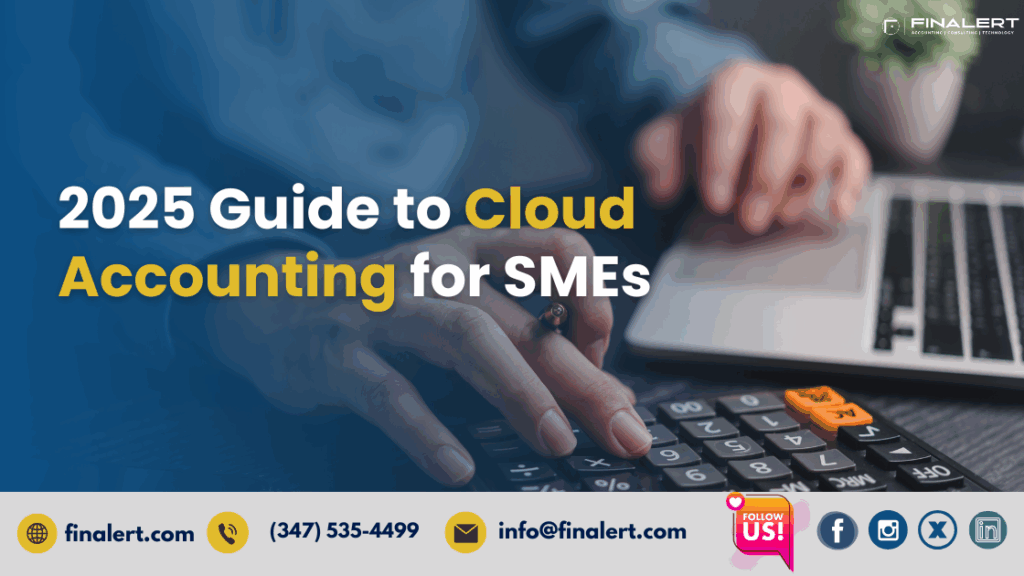
In 2025, cloud accounting is no longer just a forward-thinking solution—it’s a vital tool for small and medium-sized enterprises (SMEs) striving for operational agility, financial clarity, and sustainable growth. Traditional accounting methods have become obsolete in the face of rapidly evolving business models, remote workforces, real-time decision-making needs, and tighter compliance regulations.
This comprehensive guide explores what cloud accounting is, why it matters more than ever in 2025, the benefits it offers, how to choose the right platform, implementation strategies, and the trends shaping the future of SME finance.

Cloud accounting refers to the use of internet-based software to manage a business’s financial records. Instead of installing programs on local computers, data is stored securely on cloud servers and accessed through browsers or mobile apps.
This model ensures that financial data is constantly backed up, automatically updated, and available in real time from anywhere. It transforms bookkeeping and financial reporting into a dynamic, collaborative process rather than a static, reactive one.
The accounting landscape has drastically changed in the past few years. In 2025, the following shifts make cloud accounting not just beneficial—but necessary:
As distributed teams become the norm, businesses need financial systems that are accessible from anywhere. Cloud platforms offer seamless collaboration regardless of geography.
In today’s fast-paced markets, waiting weeks for financial reports can be a costly delay. Cloud tools provide up-to-the-minute dashboards and reporting.
Routine bookkeeping tasks—like expense categorization, invoice matching, and payroll—can now be automated. AI also provides predictive insights into cash flow, profit margins, and more.
Data privacy laws and tax regulations are becoming more stringent. Cloud systems often come with built-in compliance and enhanced security features like multi-factor authentication and encrypted backups.
SMEs can start small and scale up usage as their business grows, paying only for what they need.

Automation of reconciliation, invoice reminders, recurring billing, and tax calculations saves countless hours each month.
Machine learning reduces human error in transaction recording and ensures cleaner books at all times.
Cloud software eliminates the need for servers, regular manual backups, or maintenance, saving money and reducing downtime.
Multiple stakeholders—owners, finance teams, and external accountants—can work on the same data simultaneously without duplication or version confusion.
All data is backed up off-site, encrypted, and accessible even if physical devices are lost, stolen, or damaged.
Modern cloud accounting software integrates easily with e-commerce platforms, payroll tools, inventory management, CRMs, and POS systems.

Instantly visualize your company’s financial health, cash flow, and performance metrics without waiting on monthly closes.
Check balances, approve expenses, or issue invoices from your phone or tablet, on the go.
Choose modules you need today and expand later. Customize reports, user permissions, and templates based on your industry.
Get smart forecasts about cash flow dips, tax liability, and upcoming payment risks—based on historical and current trends.
Daily bank syncing keeps your records current and reduces reconciliation headaches.
Features like digital audit trails, e-signatures, and automated tax report generation support internal and external compliance efforts.
Here’s a look at some of the most effective options for small and mid-sized businesses in 2025:
Widely used in the U.S., this platform offers great automation, integrations, and is ideal for service businesses.
Best for global operations, Xero offers clean design, multi-currency support, and a robust mobile app.
Affordable and ideal for startups or lean teams, Zoho Books is part of a larger business suite for CRM, HR, and more.
Perfect for businesses scaling rapidly, Sage handles complex accounting and payroll needs with ease.
Focused on freelancers and solopreneurs, FreshBooks simplifies time tracking, invoicing, and expenses with ease.
List what you want from the platform: real-time cash flow, easier invoicing, tax automation, or audit readiness.
Demo multiple tools. Compare them based on ease of use, automation, integration support, and pricing.
Before migration, ensure your old data is accurate. Eliminate outdated records or duplicate entries.
Transfer all relevant data, set up your chart of accounts, user permissions, tax settings, and invoice templates.
Integrate other systems like your POS, inventory, or payroll platforms to create a single ecosystem.
Host training sessions for staff. Ensure everyone is comfortable using the platform and understands the workflow.
Track usage and performance. Use built-in KPIs to refine processes or adjust automations.
Rushing the transition can lead to data loss or misconfigurations. Always plan and test in stages.
Even user-friendly platforms require training. Undertrained staff can create bottlenecks or errors.
Migrating “dirty” data will only transfer your problems to the new system. Clean data is critical to success.
Without role-based access and approval flows, sensitive financial data could be misused. Set clear boundaries.
Cloud accounting doesn’t just replace spreadsheets—it transforms how SMEs operate:
These aren’t futuristic scenarios—they’re happening now, in 2025.
Soon, your accounting software will suggest pricing changes, alert you to profit margin dips, or recommend tax-saving strategies.
Cloud accounting will connect directly to financial institutions, enabling instant payments, real-time loans, and credit checks.
Expect immutable transaction records and auto-reconciled deals via blockchain-integrated systems.
More businesses will track environmental impact within their financial systems—integrating social responsibility with bottom-line metrics.
In 2025, cloud accounting is more than a tool—it’s the foundation of a smarter, faster, and more adaptive SME. It simplifies operations, enhances compliance, supports remote work, and empowers better decisions through real-time insights.
By selecting the right platform, aligning it with your business needs, and implementing it thoughtfully, you can modernize your financial operations and set your company up for sustainable success.
Similar Articles
No results available
Get in touch with Finalert today for tailored business solutions!
No results available
Ready to thrive? Connect with Finalert today and let’s succeed together in the dynamic global market.
© 2025 Finalert. All rights reserved.
Ready to thrive in the dynamic global market? Finalert LLC offers expert financial services, including accounting, consulting, and technology solutions, tailored to your business needs.
Address
Accounting
Quick Links
Consulting
Industries
© 2025 Finalert LLC. All rights reserved.